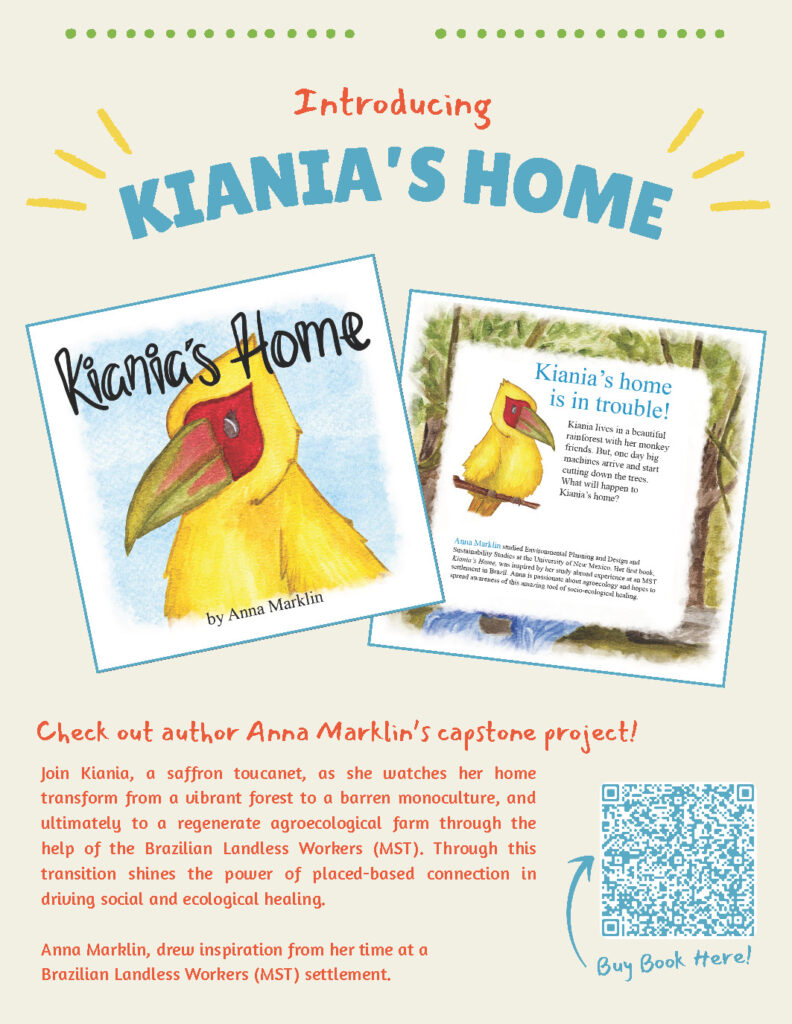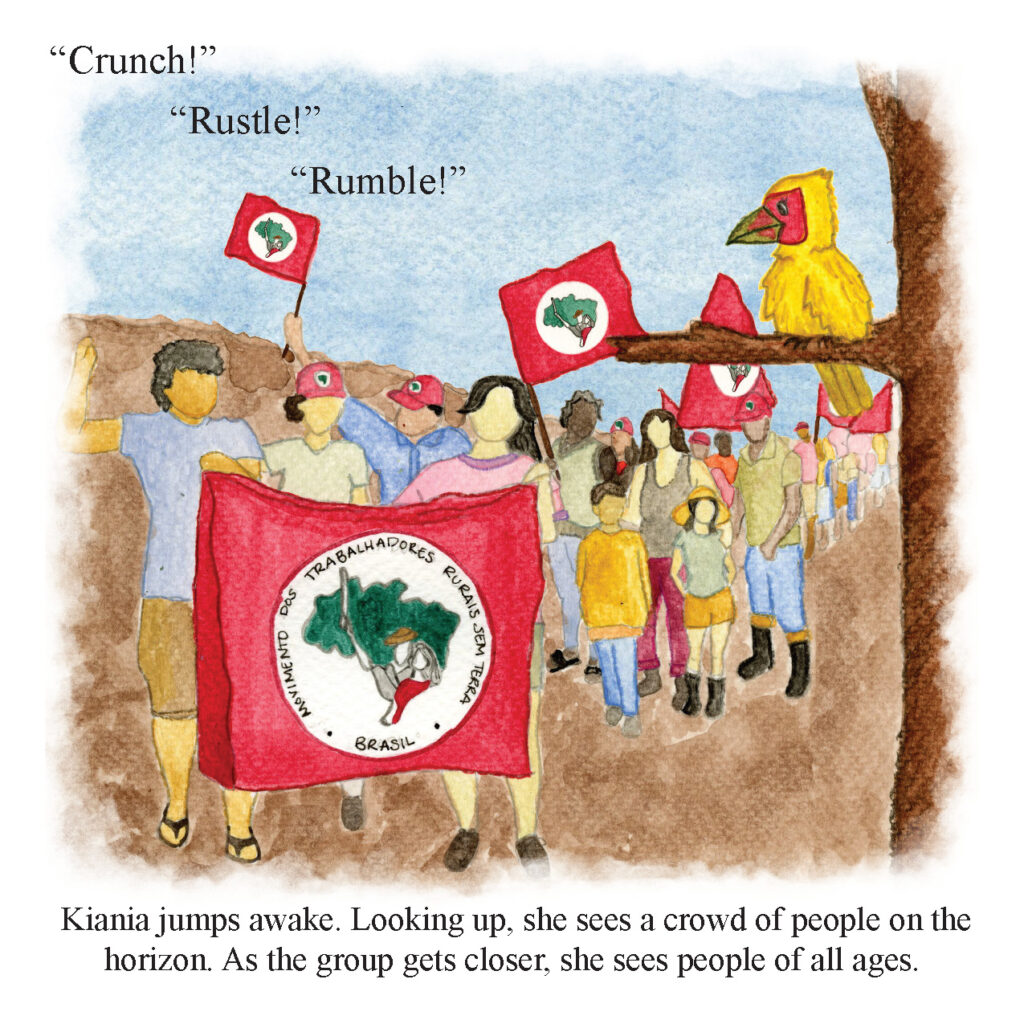New Children’s Book on the MST by Former Grassroots Intern
Interview with Anna Marklin, Author of Kiania’s Home
For Brazil’s Landless Workers Movement (Movimento dos Trabalhadores Sem Terra, MST), political formation starts from day one, with children an integral part of the daily activities and lifeblood of the movement. Now young people outside the MST can get a glimpse into this incredibly inspiring social movement, while learning broader lessons about agroecology, agrarian reform, and more through the endearing book Kiania’s Home by former Grassroots International intern Anna Marklin. Kiania’s Home is told through the perspective of a bird whose rainforest home is devastated by industrial agriculture until the MST comes and reclaims the land, gradually restoring its health and biodiversity — much to the delight and curiosity of Kiana and her friends.
Grassroots International is excited about the publication of this book on our long-time partner the MST by our stellar former intern Anna. The following is an interview with Anna about the book.
What was your motivation for writing this book?
I vividly remember the first time a book moved me to tears. I was in first grade, listening to an audio tape of The Legend of the Bluebonnet by Tomie DePaola while following along with the hardcover. When I reached the illustration of a small girl sacrificing her most precious possession to save her community, I was overwhelmed with emotion. That moment revealed to me the profound power of books and ignited a dream to one day impact the world with my own story.
Nearly twenty years later, I fulfilled that dream. When faced with the task of completing a capstone project for my Sustainability Studies minor, I knew I wanted to write and illustrate a children’s book, but I was initially unsure of the topic. My direction became clear during a life-changing study abroad trip to Brazil where I stayed with a family of the MST. I was deeply moved by the strength of the community and by the mission of the movement. Inspired, I knew that I wanted to bring this movement to the attention of youth in the US.
As I began writing the manuscript, I realized my limitations in fully grasping the political intricacies of the MST. Instead of trying to encompass all of the MST in one story, I chose to focus on what I had witnessed firsthand: the remarkable regeneration of land through the use of agroecology. This topic was especially near and dear to my heart as I grew up on a small farm in New Hampshire and have always been passionate about food and agriculture. The way the MST produces food that heals both the land and the people is truly remarkable, and I wanted to share this way of farming with the world. I aimed to craft a story that illustrates to children how our actions impact the environment and how we have the power to choose whether this impact is beneficial or harmful.
Moreover, I wanted to share the MST’s story with young readers to show them an example of people coming together as a community to fight for their rights, even when faced with systemic opposition. My goal was to empower children to question the status quo and to think critically about the kind of world they want to live in. Through my book, I hope to inspire the next generation to recognize their potential to make a positive difference in the world.
What are some key take-aways you hope young readers will have?
I was incredibly lucky to grow up in a household that cherished the land and believed it was our responsibility to steward it. From a young age, I learned about climate change and how our actions were affecting the natural world. As I journeyed through school, diving into Environmental Science and later Sustainability Studies, my understanding of our negative impact on the planet deepened. This knowledge weighed heavily on me, leading to a sense of despair. I began to believe that the best way to protect the Earth was to minimize human interaction with nature.
Everything changed during my stay with the MST. There, I discovered a transformative way of living in harmony with nature. I saw firsthand how humans can play an active and beneficial role in the ecosystem, and not only heal the environment, but also ourselves. This experience reshaped my perspective and filled me with hope. Through Kiania’s Home I want young readers to see that they are vibrant parts of both their human and more-than-human communities and have the power to create environments in which all species are respected and able to thrive.
Do you have any reflections connected to your experience as a former intern of Grassroots International?
Yes! I witnessed first-hand from the MST how important partnerships are and the power of having a strong network. This is exactly what Grassroots International supports with their solidarity philanthropy. They go beyond simply providing funds and build close relationships with their partners based on shared visions and values. They facilitate learning exchanges and help organizations connect with others in their region, thus creating the strong networks that are crucial for amplifying collective impact. Furthermore, Grassroots International’s approach recognizes that those most affected by problems are best positioned to create solutions. By partnering with local organizations that are deeply connected to the issues and the people in their communities, Grassroots helps ensure that solutions are contextually appropriate and sustainable. In my experience, this approach creates a powerful synergy between international resources and local knowledge, leading to more effective and lasting change. It’s a model that respects the autonomy and expertise of local movements while providing crucial support and solidarity. I cannot emphasize enough how important Grassroots International’s support of the MST is as they do their vital work to heal land and people.
Anything else?
I feel like I could go on and on about the MST and this book, especially since the journey of creating this book was so long. I will share that I have enlisted the help of two friends to translate the book into Spanish and Portuguese so that I can reach a broader audience. I am also hoping to have the book picked up by a publishing house so that I can offer a hardcover version.




